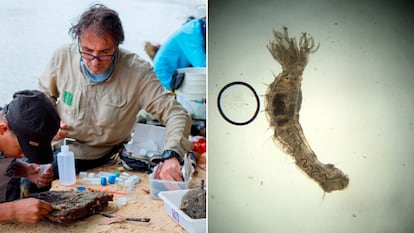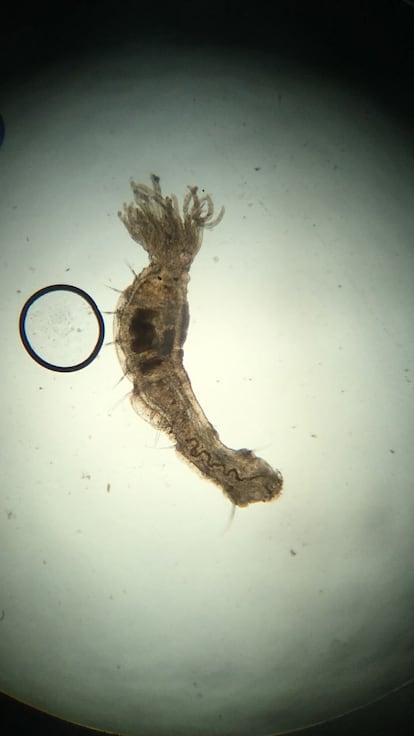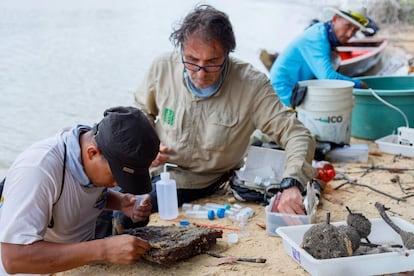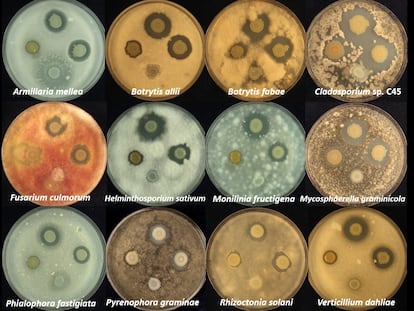A strange worm emerges from one of South America’s longest rivers
The Spanish biologist who discovered the freshwater creature in the Orinoco River thinks that it has a lot of information to offer us

A couple of years ago, biologist Carlos A. Lasso did a double-take when he examined what turned out to be a strange-looking worm with a magnifying glass. He thought that the object could have possibly been “the root of a plant, a vegetable stem, or another unknown organism.”
During the Covid-19 pandemic, he sent the sample to an expert. A few months later, the specialist, Mario Londoño, of the University of Antioquia in Medellín, confirmed the discovery: this was a freshwater worm from the depths of the Orinoco, a 1,700-mile-long river that makes up parts of the border between Venezuela and Colombia.
“Freshwater species are usually found near the coast. The remarkable thing is that I found these worms in deep and rapid waters, more than 600 miles away from the ocean,” Lasso explains.
Another thing that caught the biologist’s attention was that the worms “were attached to mollusks.” According to Lasso’s hypothesis, this would imply a relationship between the invertebrates.
For more than 12 years, Lasso - a native of Madrid who has worked in Latin America for nearly four decades - has been conducting surveys to study the biodiversity of aquatic fauna and hydrobiological resources at the mouth of the Orinoco. He is based in the Colombian municipality of Puerto Carreño, capital of the department of Vichada.
“We take advantage of the dry season, from January to April - when the river level doesn’t exceed 30 feet - to make the dives,” explains the researcher, who is affiliated with the Bogotá-based Humboldt Institute.
Lasso and Londoño believe that the specimen - unknown to the scientific community until now - belongs to the genus Manayunkia, of the Sabellidae family. It is “a vector of parasites in fish, such as salmon, which could be important for the aquaculture industry,” says the biologist. He also thinks that, in addition to its parasite-trapping capacities, the worm could constitute proof of “the transgressions and marine regressions suffered by the Amazon and Orinoco regions.”

Some heavily debated scientific theories suggest that an extensive and shallow sea may have covered large parts of South America - including the Amazon and Orinoco Basin - for millions of years. According to a 2017 study published in the journal Science Advances, the Caribbean Sea bathed the freshwater territories that are made up of present-day Venezuela and Colombia on two different occasions during the Miocene, the first geological epoch. This thesis would explain the evolution and distribution of fauna in the region.
“Like the Amazon, the Orinoco - which can reach more than 300 feet in depth - was subject to changes in its ecosystem, which caused some species to become extinct and others to survive by adapting to the new conditions. This is already evident in jellyfish or freshwater stingrays, whose ancestors were found in these rivers,” explains Lasso.

With more than 1,650 fish identified so far, one of the characteristics that marks the Orinoco ecosystem is its amazing biodiversity. According to the Spanish biologist, “every time an exploration is carried out in this region, something new is found. Finding unknown organisms in the tropical environments of South America is relatively common.”
To find new fauna, which often remains hidden in unexpected places, Lasso goes beyond standard collection methods. “I carry out nocturnal sampling at great depths with zooplankton trawls, with light traps and underwater dives,” he says. Lasso is accustomed to patiently inspecting the strangest habitats, often sticking his magnifying glass inside trunks and roots.
“At the [Humboldt Institute], together with the University of Los Andes, we carry out deep-sea studies of environmental DNA, known as metabarcoding,” he explains. This new technique - which studies the genetic material freely roaming in ocean ecosystems and in many aquifer systems - is a non-invasive method to assess the composition and distribution of organisms in various habitats.
Lasso and several specialists from the University of Antioquia have formed a working group to continue gathering knowledge about the new worm. “I’m in charge of collecting ecological information… the other group is focusing more on the genetic aspects [of the worm],” says the biologist.
Tu suscripción se está usando en otro dispositivo
¿Quieres añadir otro usuario a tu suscripción?
Si continúas leyendo en este dispositivo, no se podrá leer en el otro.
FlechaTu suscripción se está usando en otro dispositivo y solo puedes acceder a EL PAÍS desde un dispositivo a la vez.
Si quieres compartir tu cuenta, cambia tu suscripción a la modalidad Premium, así podrás añadir otro usuario. Cada uno accederá con su propia cuenta de email, lo que os permitirá personalizar vuestra experiencia en EL PAÍS.
¿Tienes una suscripción de empresa? Accede aquí para contratar más cuentas.
En el caso de no saber quién está usando tu cuenta, te recomendamos cambiar tu contraseña aquí.
Si decides continuar compartiendo tu cuenta, este mensaje se mostrará en tu dispositivo y en el de la otra persona que está usando tu cuenta de forma indefinida, afectando a tu experiencia de lectura. Puedes consultar aquí los términos y condiciones de la suscripción digital.
More information
Archived In
Últimas noticias
Sinaloa Cartel war is taking its toll on Los Chapitos
Venezuela hardens its ‘revolutionary state’ project amid pressure from Trump
Sydney Sweeney, the actress praised by Trump: ‘Women are up against what society wants them to be’
The Bolsonaro surname: An advantage or liability in Brazil’s 2026 presidential elections?
Most viewed
- Reinhard Genzel, Nobel laureate in physics: ‘One-minute videos will never give you the truth’
- Pablo Escobar’s hippos: A serious environmental problem, 40 years on
- Charles Dubouloz, mountaineering star, retires at 36 with a farewell tour inspired by Walter Bonatti
- Why we lost the habit of sleeping in two segments and how that changed our sense of time
- The fall of a prolific science journal exposes the billion-dollar profits of scientific publishing










































